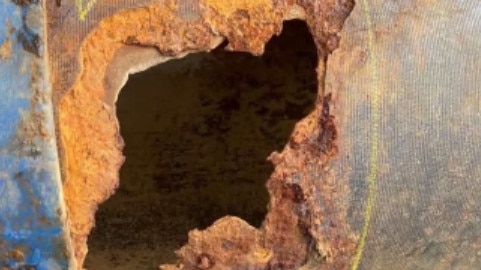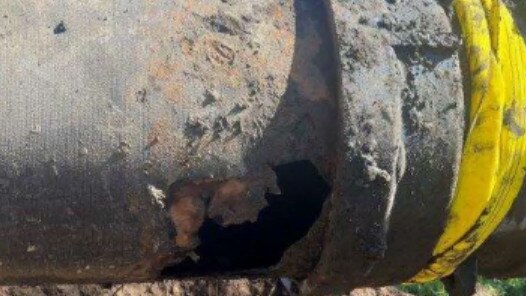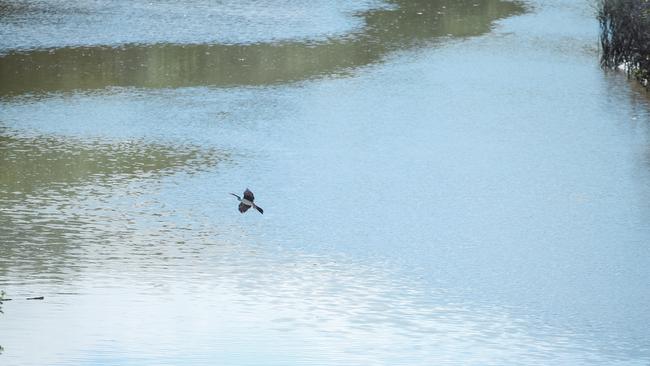Independent report findings show key failings of the Albert River sewerage spill
The reasons for the shocking 350-million litre sewage spill into the Albert River have been laid bare to the Gold Coast council. Read the revelations and how it will be fixed
Gold Coast
Don't miss out on the headlines from Gold Coast. Followed categories will be added to My News.
The months long sewer leak into the Albert River was caused by corrosion of the pipe, a lack of specialised wrapping on it and failure of detection systems, it can be revealed.
City of Gold Coast council says it has reviewed and accepted all recommendations from an independent investigation into the sewer main break in Stapylton which flowed into the Albert River earlier this year.
The investigation by AECOM Australia focused on two key areas – the cause of the break and the delay in detection.
The key findings include:
* The City’s dependence on breaks being reported by members of the public, a measure which is ineffective for isolated mains.
* Higher than average flows in the Albert and Logan River reduced the potential for river users to notice the spill.
* The flow meter at the Beenleigh Sewage Treatment Plant was not alarmed or monitored regularly by the City.
* No advice was received from Logan City Council about reduced inflows over the period of the spill.

Investigators found that once detected, the repair was completed in “good time”.
Council has made the report available for the public at its website.

The City says it continues to work collaboratively with the Department of Environment Science and Innovation (DESI) and specialist consultants to undertake water quality modelling to better understand any environmental impacts with results expected next month.
City CEO Tim Baker welcomed the AECOM report and said the council commenced implementation of several key recommendations in April following the detection of the leak.
“The City is committed to rigorous and continual improvement across all areas, and we are committed to applying lessons learnt to prevent future incidents,” Mr Baker said.
He said the investigation determined that the break was due to corrosion most likely caused by “aggressive” soil or groundwater, and the omission of a specified wrapping for the pipe at the time of installation (2005) was also a contributing factor.
It also found that condition assessments of the main and a proposed project that would have reduced flows and enabled pipeline renewal had been deferred.
Several recommendations include reviewing the City asset management strategy and undertaking planning for critical sewage rising mains.
Others include growing the size of our asset management team, improving technology and instrumentation to detect flows and breaks, reviewing the condition of pipes installed in the same period. revising the City’s arrangement with Logan City Council.
“Much of this work is already underway including the development of a four-year critical sewerage pressure main plan, targeted condition assessments of all high-risk mains and reviewing of the specific piping installed during that period,” Mr Baker said.

The root causes of the incident were related to processes and structures that were no longer in place or already under review, he added.
“We are a City that has undergone incredible transformation in the last few years. This included restructuring our water business and doubling our investment in asset renewal.
“We can assure the community that we have taken this incident very seriously and due to our new structure and operating model we were able to quickly address the issues,” he said.
Mr Baker said the City continued to co-operate with DESI’s investigation into the incident.
Logan City Council says it is co-operating with a State Environment Department probe.
A Logan City Council spokesperson: “We are aware the Department of Environment Science and Innovation has commenced a formal investigation into the spill. We have been and will continue to fully participate in the investigation.”
The Bulletin in early April in an exclusive report detailed how a major sewerage pipe linking to the waste water treatment plant had broken causing untreated effluent to flow into river.
Residents had spotted more than 20 tankers working to suck up sewage from a pipe near the Yatala Pie factory, to relieve pressure on the system as teams repaired the leak by the river.
They accused council of keeping the lid on the environmental disaster for at least a week with only a council sign by a roadside and taped section off a pedestrian walkway warning of an “environmental incident” and advising against swimming or fishing.

The State Environment Department later that month confirmed it was investigating council for a “catastrophic failure” of its systems after the sewer spill.
More than 350 million litres of sewage was estimated to have spilled into the river from January 12 to April 12, the Department said.
“Gold Coast City Council is under investigation for a catastrophic failure of its systems following a significant sewage spill from a council pipe at Yatala,” a DESI statement said.
Department regulators began examining the extent of environment harm, timeliness of council notification of health risks, and council culpability in management of its sewage network.
Officers were to assess the council’s network infrastructure maintenance and management program to determine if the City was adequately managing and maintaining ageing assets.
It could result in enforcement action against council, including a statutory notice and prosecution. The investigation has yet to be finalised.

A Department spokesperson, at the time, said: “The Gold Coast City Council is the polluter. The council is responsible for ensuring appropriate testing and monitoring of the Albert River and flow-on waterways.
“Council is also responsible for communications to community and industry stakeholders about appropriate recreational and commercial risks. DESI, along with Queensland Health,

Safe Food Queensland and the Department of Agriculture and Fisheries have been liaising with the council regularly, encouraging them to test for a broad suite of contaminants and maintain open and accurate communications.”
Later that month council after pressure from community groups about transparency confirmed “an external consultant will be engaged to undertake an independent investigation”.
Mayor Tom Tate in May said he was surprised by the Albert River sewage spill and admitted the council’s infrastructure failed and needs an overhaul.





